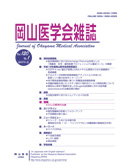

Journal of Okayama Medical Association
Published by Okayama Medical Association<Availability>
Full-text articles are available 3 years after publication.
Permalink : https://ousar.lib.okayama-u.ac.jp/19469
Studies on the Treatement for Gastric and Duodenal Ulcer by the Intramuscular Injection of Bismuth SubsaliylatePart, Ⅱ Observations on the Intramuscular Injection of Bismuth Subsalicylate in Oil
Kondo, Hiroshi
Published Date
1956-05-31
Abstract
In part, Ⅱ the author investigated the histological staining possibilities of various bismuth compounds and then, by the intramuscular injections, verified the distribution of bismuth in the tissues of the stomach and of the duodenum both in men and rabbits. It was noticed that the conditions of the recipients (men and rabbits) received the injection had turned for the better with the continuous decrease in the acidity of the gastric juice. The cause of these changes was histopathologically found to be due not only to the direct action of Bismuth contained saliva on the ulcer but also to the chemical reaction between bismuth and gartric acid, and thus apparently to a beneficial effect of bismuth on the function of the stomach tissue-cells. By this experiment, it is considered that water-soluble bismuth tartarate which absorbed or secreted quite rapidly is rather harmful than the more slowly absorbed and secreted one like oil-soluble bismuth subsalicylate. So I believe that the latter is more suitable for the treatment of the gastric ulcers. Moreover, the chemical quantitative value of bismuth in the tissues of man suggests that this substance (bismuth subsalicylate) will be slowly and protractedly absorbed and secreted, and consequently acts on the gastric tissue for a considerably long period. The present investigation has proved that intramuscular injection of bismuth subsalicylate will act gradually for a long time and that, when once administered, bismuth subsalicylate is continuously effective for the gastric and duodenal ulcers.
ISSN
0030-1558
NCID
AN00032489
